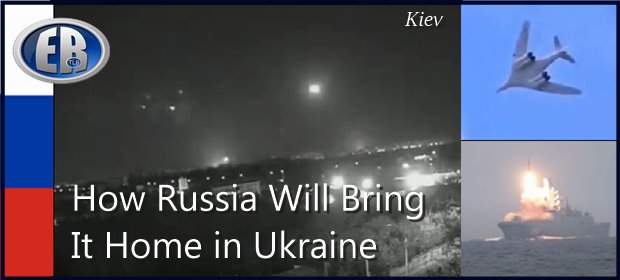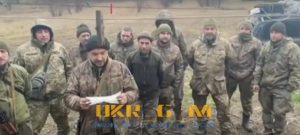
ER Editor: The grinding, winning strategy of Russia moves along. Moon of Alabama makes strategic, militaristic and economic sense of what’s going on below.
The Saker in this recent piece (Making sense of NATO strikes against Russia) views NATO as pushing Russia into retaliation, moving it off its schedule (in relation, for example, to the recent Ukrainian military bombing of a new year’s party with many new Russian recruits present). The Saker says this won’t happen; MoA gives us a sketch of strategy and timing.
***
Respected analysts such as Scott Ritter and Colonel Douglas McGregor have tallied huge Ukrainian manpower losses over the past months, prompting some to note that were the Polish fighters, for example, to reverse their jackets and stop pretending to be Ukrainian, the war could turn into a takeover of Ukraine by Poland. So it’s often been said, the West/NATO is fighting in Ukraine ‘down to the last Ukrainian’, prompting some like MoA to call this use of Ukrainian forces ‘criminal’. Here’s a recent reminder of how hopeless it has been for Ukrainian servicemen (browsers will translate):
A group of Ukrainian fighters have known to Zelensky that they refuse to fight

About 15 mobilized soldiers of the 3rd Company of the 98th Battalion of the 60th Brigade of the Ukrainian Armed Forces have recorded a video confessing that they do not want to fight. The soldiers turned directly to Volodymyr Zelensky, message Reporter.
According to the military, the technical state of the military equipment at their disposal is extremely low, the machine guns are out of order, the mortars do not work – with such weapons it is impossible to carry out high quality combat missions. At the same time, about 70 percent of fighters suffer from health problems, but commanders do not leave the soldiers. The higher authorities practically do not respond to the problems raised.
In addition, military training for mobilized civilians is organized inefficiently. …
Meanwhile, more and more Ukrainian military personnel are leaving their combat positions, unable to stop the attack by the Russian armed forces. For example, soldiers of the 128th Mountain Assault Brigade of the Ukrainian Armed Forces were seen deserting in the Soledar region.
***
We recommend this historical overview by Dmitry Orlov at ClubOrlov (paywall) – The Last Crusade, Part II:
We are, most of us unwittingly, bearing witness to a momentous development: the end of the thousand-year Drang nach Osten—the relentless eastward march of the reanimated corpse of the Western Roman Empire, with the Pope as its symbolic head and Vatican as its symbolic capital—known as the Crusades. Of these, the Southern Crusades are far better known in the West, while the Northern Crusades, launched in 1147, are far less widely known. But they were kept going the longest—until February 22, 2022—because, unlike China, India and just about every other non-Western country, Russia has never surrendered to anyone. …
There followed a series of onslaughts on Russia spanning many centuries, all stemming from the same simple principle: that which the West cannot control must be destroyed. …
Some knowledgeable commentators have observed how Russia has been waiting a thousand years for this moment.
It’s moved a ship supplied with hypersonic missiles into the Pacific and Indian Oceans, meanwhile:
Russian President Vladimir Putin on Wednesday ordered a warship armed with new hypersonic Zircon cruise missiles to be deployed on a mission to the Atlantic and Indian Oceans, in what could be a message and warning aimed at the West against escalating in Ukraine. …
“This ship, armed with ‘Zircons’, is capable of delivering pinpoint and powerful strikes against the enemy at sea and on land,” Shoigu had responded to the Putin announcement. The defense chief also stressed the Zircon is undefeatable, able to evade any anti-air defense system in the world due to its purported ability to fly at nine times the speed of sound.
********
Ukraine – The Big Push To End The War
MOON OF ALABAMA
Over Christmas I had a short talk with a relative about the war in Ukraine. He asked me who would win and was astonished when I said: “Ukraine has zero chance to win.” That person reads some German mainstream news sites and watches the public TV networks. With those sources of ‘information’ he was made to believe that Ukraine was winning the war.
One may excuse that with him never having been in a military and not being politically engaged. But still there are some basic numbers that let one conclude from the beginning that Russia, the much bigger, richer and more industrialized country, had clearly all advantages. My relative obviously never had had that thought.
The ‘western’ propaganda is still quite strong. However, as I pointed out in March last year propaganda does not change a war and lies do not win it. Its believability is shrinking.
Former Lt.Col. Alex Vershinin, who in June pointed out that industrial warfare is back and the ‘West’ was not ready to wage it, has a new recommendable piece out which analyses the tactics on both sides, looks ahead and concludes that Russia will almost certainly win the war:
Wars of attrition are won through careful husbandry of one’s own resources while destroying the enemy’s. Russia entered the war with vast materiel superiority and a greater industrial base to sustain and replace losses. They have carefully preserved their resources, withdrawing every time the tactical situation turned against them. Ukraine started the war with a smaller resource pool and relied on the Western coalition to sustain its war effort. This dependency pressured Ukraine into a series of tactically successful offensives, which consumed strategic resources that Ukraine will struggle to replace in full, in my view. The real question isn’t whether Ukraine can regain all its territory, but whether it can inflict sufficient losses on Russian mobilized reservists to undermine Russia’s domestic unity, forcing it to the negotiation table on Ukrainian terms, or will Russian’ attrition strategy work to annex an even larger portion of Ukraine.
Russian domestic unity has only grown over the war. As Gilbert Doctorow points out, wars make nations. The war does not only unite certain nationalistic parts of Ukraine who still dream of retaking Crimea. It also unites all of Russia. Unlike Ukraine, Russia will be strengthened by it.
Casualties are expected in wars and the Russians, with their steady remembrance of the second world war as their Great Patriotic War, know this well. Screw ups also happen and at times some bad leadership decisions puts people into the wrong place where the enemy can and will kill them. That is what happened in Makeyevka (Donetsk) on New Years day 2 minutes after midnight. Some 100 Russian reservists died. The Russian leadership pointed out that they were killed by U.S. HIMARS missiles. The former Indian diplomat M. K. Bhadrakumar judges that this was a U.S. escalation which will likely receive a response:
The intelligence inputs in real time show direct American participation in the horrific operation targeting the Russian conscripts’ New Year party just when the toasts began. Of course, whipping up public sentiments in Russia against Putin is a core American objective in the war. We are entering a grey zone. Expect “surgical strikes” by the Russian forces, too. After all, at some point soon enough, it will emerge that what’s sauce for the goose is sauce for the gander.
Some retaliation has already happened. Yesterday the Russian Defense Ministry reported that over 130 foreign mercenaries were killed in attacks on their bases near Maslyakovka and Kramatorsk. Those Polish soldiers are now gone. The Russian military also continues its quite successful counter-artillery campaign:
Missile and air strikes launched at a hardware concentration near Druzhkovka railway station (Donetsk People’s Republic) have resulted in the elimination of:
- two launching ramps for U.S.-manufactured HIMARS multiple-launch rocket systems (MLRS);
- four armoured fighting vehicles for Czech-manufactured RM-70 Vampire MLRS;
- over 800 rockets for MLRS;
- six motor vehicles, and up to 120 Ukrainian personnel.
Within the counterbattery warfare, two launching ramps for U.S.-manufactured HIMARS MLRS, that were used for shelling settlements of the Donetsk People’s Republic, have been detected and destroyed near Kramatorsk. Three U.S.-manufactured M-777 artillery systems have been destroyed at their firing positions near Artyomovsk (Donetsk People’s Republic), and Chervonaya Dibrova (Lugansk People’s Republic).
Two Ukrainian fighting vehicles for Grad MLRS have been destroyed near Volchansk (Kharkov region) and Serebryanka (Donetsk People’s Republic).
Two D-30 howitzers have been destroyed near Kamenskoye and Gulyaypole (Zaporozhye region).
Those are four HIMARS, three M-777, some Czech ‘aid’, 800 HIMARS missiles and some Ukrainian guns that were lost in just one day. That was probably more than the ‘West’ can deliver over the next months.
Even the New York Times notes that Russia is exhausting the Ukraine as well as its western support by simply throwing cheap stuff at it:
The Iranian-made Shahed-136 drones that Moscow has increasingly been relying on since October are relatively uncomplicated devices and fairly cheap, while the array of weapons used to shoot them out of the sky can be much pricier, according to experts. The self-destructing drones can cost as little as $20,000 to produce, while the cost of firing a surface-to-air missile can range from $140,000 for a Soviet-era S-300 to $500,000 for a missile from an American NASAMS.
This only confirms the point Alex Vershinin was making. Russia has cared for its resources while the Ukraine, and NATO, have wasted their stuff mostly in senseless frontal campaigns against well protected Russian troops.
Yves Smith of Naked Capitalism points out that Vershinin has left out the economic side of the war where the picture is as bad for Ukraine as it is on the ground:
Ukraine is dependent on the West to fund its government, giving new meaning to the expression “client state”. Ukraine’s GDP contraction is estimated to be on the order of 35-40% for 2022. Ukraine in November projected its 2023 budget deficit to be $38 billion. Mind you, that is for essential services and is likely to underestimate the cost and knock-on effects of dealing with Russia’s attacks on its electrical grid. Again, before the grid strikes, the IMF had estimated Ukraine’s budget needs at $3 to $4 billion a month. It’s an easy bet that that $38 billion funding gap will easily come in at more than $50 billion.
And paying for teachers’ salaries, pensions, road repair, hospitals, are not the sort of thing that enriches the military-industrial complex. This is a huge amount for the West. Euronews, in discussing the then estimated $38 billion hole, strongly hinted Ukraine would come up short: …
Yves Smith also points out that, as we predicted in March, the pro-Ukraine propaganda is not really fixing the war:
Last and not at all least, the success of Ukraine propaganda seems to be falling despite the media and politicians doing their best to create the impression otherwise. Lambert and I were both very much surprised to read that a recent poll of likely US voters (as in presumably politically engaged) found fewer than 1/3 thought Ukraine was winning the war.
Lastly to find out who will win this war, we can point to the mid December interview the Ukrainian war leader General Valery Zaluzhny gave to the Economist:
General Zaluzhny, who is raising a new army corps, reels off a wishlist. “I know that I can beat this enemy,” he says. “But I need resources. I need 300 tanks, 600-700 IFVs [infantry fighting vehicles], 500 Howitzers.” The incremental arsenal he is seeking is bigger than the total armoured forces of most European armies.
What Zaluzhny really says is that the war is lost if he does not get those resources. He knows well that is he will not receive them.
So how will Russia proceed towards the end game?
Dima of the Military Summary Channel discussed yesterday how two big moves, one up from the Mariupol (south) area and one down west of Kharkiv (north-east), can cut all railroad lines that connect west Ukraine with the eastern frontline, where some 80+% of the Ukrainian army is now deployed.
I agree that the move from the south will happen, but I am less sure about the northern branch.

bigger

Source – bigger
Both are big 200 kilometer (120 miles) long moves that require significant amounts of forces. But after its mobilization and with volunteers, Russia has 350,000 additional forces it can move in. 75 to 100,000 are sufficient for each push while the rest can keep the Ukrainian troops in the east very busy and fixed in their position.
Then comes the question of when.
Due to currently warmer than normal weather, the ground in Ukraine is not yet frozen and the mud will return in March and April. That gives only a two months window to move forward. If I were the Russian commander I would probably wait and use the six dry months during the summer. But there are other criteria, like politics and economics, that will come into play and which may require an earlier move.
If the plan works, the war will largely be over. Russian troops will be free to move anywhere in Ukraine with only little resistance. A move to retake Kherson and Odessa (ER: both in the south, south-west) will then be a rather easy and short affair.
The big question is, how the U.S. will respond. If the Ukraine falls, the U.S. and NATO will have lost their war against Russia. That will cause serious political damage.
Thomas H. Lipscomb writes that war will be lost because it was badly planned and in a way that could never have changed its direction:
American military planning was once world class. But who would plan a proxy war against Russia, one of the acknowledged masters of artillery with far better air defense technology than any in the West, and then equip our puppet Ukraine with inferior weapons and only enough ammunition to last six months? And surely American planners couldn’t help knowing that there was no longer a manufacturing base for resupply, and NATO warehouses were practically empty?
This will have wide ranging consequences:
[T]he United States current leadership is a bunch of total idiots, blinded by ideology, arrogance and illusions of pursuing a “rule-based” global hegemony, an opportunity long passed, as our performance in this proxy war shows. The United States may have won the Cold War but it lost the peace. Its strategic thinking and its military is obsolete and configuration of both forces and equipment is based on assumptions from the past millennium. The battle for a Great Global Reset under a unipolar American hegemony has been lost as well. The World Economic Forum is now about as relevant as the Holy Roman Empire. All they can continue to do is terrorize the increasingly authoritarian states of the West with asinine policy proposals. The attempt to destroy Russia prodded it to a burst of brilliant diplomacy and leadership by Putin and his team that has quietly established that the rest of the world prefers sovereignty and a multi-polar world. The post Cold War “Pox Americana” as Larry Johnson has called it, is over. Historians of the future will study this period of history with fascination. Few times in history has such immense change happened so fast.
The effect of losing the war will be noticed in global and domestic politics. ‘Western’ global standing will be degraded and the leadership of the war party will receive some well deserved bashing.
But will the U.S. let that happen? Can it allow itself to lose this war? Or will it escalate? Even when that is likely to only worsen its situation?
I have no idea yet how and who in Washington will decide on those questions.
************
Source

••••
The Liberty Beacon Project is now expanding at a near exponential rate, and for this we are grateful and excited! But we must also be practical. For 7 years we have not asked for any donations, and have built this project with our own funds as we grew. We are now experiencing ever increasing growing pains due to the large number of websites and projects we represent. So we have just installed donation buttons on our websites and ask that you consider this when you visit them. Nothing is too small. We thank you for all your support and your considerations … (TLB)
••••
Comment Policy: As a privately owned web site, we reserve the right to remove comments that contain spam, advertising, vulgarity, threats of violence, racism, or personal/abusive attacks on other users. This also applies to trolling, the use of more than one alias, or just intentional mischief. Enforcement of this policy is at the discretion of this websites administrators. Repeat offenders may be blocked or permanently banned without prior warning.
••••
Disclaimer: TLB websites contain copyrighted material the use of which has not always been specifically authorized by the copyright owner. We are making such material available to our readers under the provisions of “fair use” in an effort to advance a better understanding of political, health, economic and social issues. The material on this site is distributed without profit to those who have expressed a prior interest in receiving it for research and educational purposes. If you wish to use copyrighted material for purposes other than “fair use” you must request permission from the copyright owner.
••••
Disclaimer: The information and opinions shared are for informational purposes only including, but not limited to, text, graphics, images and other material are not intended as medical advice or instruction. Nothing mentioned is intended to be a substitute for professional medical advice, diagnosis or treatment.





Leave a Reply